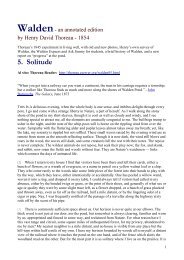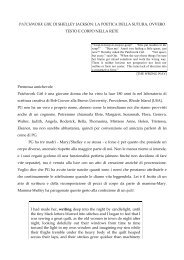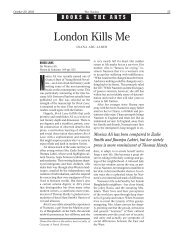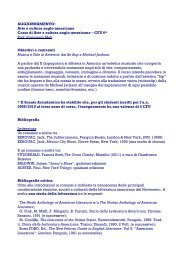Rewriting Woolf s Mrs. Dalloway: Homage, Sexual ... - Paola Carbone
Rewriting Woolf s Mrs. Dalloway: Homage, Sexual ... - Paola Carbone
Rewriting Woolf s Mrs. Dalloway: Homage, Sexual ... - Paola Carbone
You also want an ePaper? Increase the reach of your titles
YUMPU automatically turns print PDFs into web optimized ePapers that Google loves.
Mr. <strong>Dalloway</strong>: Queering Richard <strong>Dalloway</strong>Robin Lippincott's Mr. <strong>Dalloway</strong> is, perhaps, the most converitional of thesethree refashioiiiiigs of <strong>Woolf</strong>'s <strong>Mrs</strong>. <strong>Dalloway</strong>. Siiice at least the publication ofJean Rhys's Wide Sargasso Sea (1966), a companion story to Jane Eyre focusingon Rochester's first wife, the so-called "madwoman in the attic," and John Gardner'sGrendel (1971), a retelling of Beowulf from the monster's perspective, onetrend in retellings has been to give previously unheard voices an opportunity tospeak. In recent decades, as attention to issues of gender, class, sexual orientation,and race has altered the way in which we read canonical texts, manyretellings have sought to shift the narrative perspective to a more marginal locus.For example, in Mary Reilly (1990), Valerie Martin retells Dr. Jekyll and Mr.Hyde from a servant's point of view. Although Lippincott's decision to shift hisnarrative focus from an upper-class white woman to an empowered white male,a former member of Parliament, hardly suggests marginalization, Richard,through Lippincott's reworking, is limned as gay or bisexual. The impetus hereis to demonstrate that the sexual orientation of Richard, like that of his wifeClarissa, is equally ambiguous, complex, and veiled in secrecy. The relativelydull and conventional man whose life is briefly sketched in <strong>Woolf</strong>'s novel provesto have an even more engaging and surprising interior life than his wife.As a retelling, Lippincott's novel remains even closer to <strong>Woolf</strong>'s than Cunningham's,particularly in the way in which he imitates her style and feel:Mr. <strong>Dalloway</strong> said he would buy the flowers himself.For he wanted to surround Clarissa with them; to choose those flowers,thosecolours, which would set her off to the best possible advantage; which wouldcomplement her. But what colours those would be, he had no idea. And sohe had asked Lucy (now he was applying his bowler hat as he examined himselfin the hallway looking-glass). And what was it Lucy had said (she waspolishing silver at the time; he remembered the refracted artificial light slicingthrough the room): pinks; lavenders; shades of yellow; periwinkle blues?"Pale colours, sir," he thought she had said. Yes (he straightened his tie), thatwas it. (3-4)Lippincott's act of ventriloquy is accomplished, even beautiful in places; but thefinal product is somewhat disappointing and hollow, as is often the case with thework of copyists who imitate famous paintings. In addition, although Lippincott,like Cunningham, appropriates events from <strong>Mrs</strong>. <strong>Dalloway</strong>—the buying of flowers,the eruption of a loud noise from the street while at the florist—those allusionsdo not necessarily serve a significant purpose. Whereas a retelling set in thecontemporary era may offer a contrast or engage in dialogue with the world within<strong>Woolf</strong>'s novel, Lippincott's decision to set his novel in the same general timeperiod as <strong>Woolf</strong>'s prevents us from experiencing the kind of temporal interplaythat is found in The Hours or John Updike's "Scarlet Letter Trilogy." Further,372 CRITIQUE








